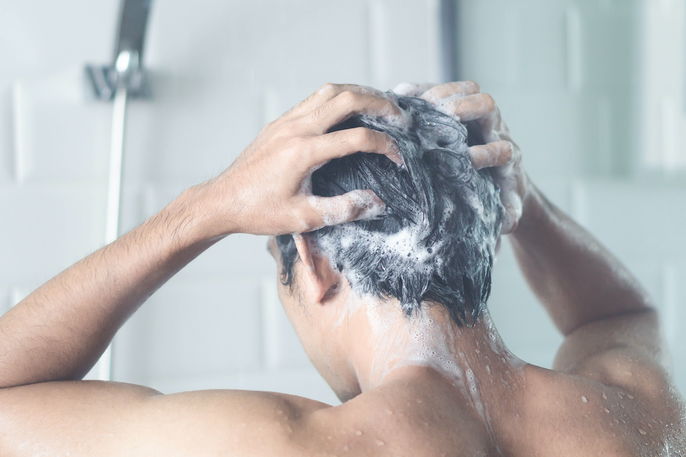Seborrheic dermatitis treatment may involve anti-dandruff shampoos or antifungal which can be prescribed by the dermatologist to eliminate the fungus that causes seborrheic dermatitis. The doctor may also prescribe corticoid ointments to reduce inflammation of the skin, which helps to relieve the symptoms like itching, redness or flaking of the skin.
Seborrheic dermatitis is a skin condition that is very common in the first few weeks of a baby's life, but can also appear in adulthood, especially in people with previous skin problems. It is most commonly seen on the scalp, but can also occur on oily areas of the skin such as the sides of the nose, ears, beard or chest.
Seborrheic dermatitis treatment should be oriented by a dermatologist who can indicate the best treatment approach, based on the severity of symptoms and the frequency with which they appear. In addition, some precautions are important during treatment, such as avoiding washing your hair with very hot water and avoiding greasy foods.

Treatment options
The main treatment options for seborrheic dermatitis that may be prescribed by a dermatologist are:
1. Shampoos for seborrheic dermatitis
Shampoos to treat seborrheic dermatitis are typically regarded as anti-dandruff shampoos, as they have an antifungal or astringent action that helps to eliminate the fungus that causes this skin condition. They reduce excessive oiliness in the hair and cleanse the hair fibers. These shampoos help to relieve the symptoms of itching, redness or dandruff on the scalp.
The main ingredients in anti-dandruff shampoos for seborrheic dermatitis are:
- Selenium sulfide
- Zinc pyrithione
- Coal tar
- Ketoconazole
- Salicylic acid
- Cyclopirox olamine
These shampoos can initially be used daily or every other day. They are applied to the scalp or beard, left on for 5 to 10 minutes, and rinsed off immediately. Instructions may vary depending on the type of shampoo prescribed.
If symptoms improves, use can be reduced to twice a week or less often for maintenance and prevention.
To avoid drying out the skin, you can use a moisturizing shampoo after using anti-dandruff shampoos.
Also recommended: Home Remedies for Dandruff: 8 Options & Recipes tuasaude.com/en/home-remedies-for-dandruff2. Ointments for seborrheic dermatitis
Ointments for seborrheic dermatitis are often prescribed by a dermatologist for more serious cases, when shampoos are not effective either in preventing seborrheic dermatitis flare-ups or treating active symptoms.
The main ointments for seborrheic dermatitis are:
- Ketoconazole
- Miconazole
- Clotrimazole
- Terbinafine
- Betamethasone
- Hydrocortisone
- Desonide
These ointments help to reduce skin inflammation and eliminate the fungus that causes seborrheic dermatitis. They should be applied to the affected area of skin, in the doses and for the duration of treatment prescribed by the doctor.
Online symptom checker
Seborrheic dermatitis is a type of dermatitis, like contact dermatitis and perioral dermatitis. To find out if you have dermatitis, report your symptoms below:
This quiz is only a guidance tool, and should not be used to confirm a diagnosis, nor does it replace consultation with a dermatologist or general practitioner.
Treatment for babies
Seborrheic dermatitis in babies, also referred to called cradle cap, is generally not a serious condition. This type of dermatitis appears before the age of three months and typically resolves after the first year of life. It occurs on the scalp and eyebrows, as well as in the folds of the legs, for example, and disappears on its own after a few months.
You should wash the baby's hair with water and a pH-neutral shampoo suitable for babies and, after bathing, comb the scalp with a soft-bristled brush to remove any scales.
Another option is to moisten the scabs with slightly warm mineral oil, as recommended by the pediatrician, before bathing, to make it easier to remove the scabs with the brush or comb. Afterwards, you can apply a petroleum jelly or zinc oxide ointment.
In rare cases, a secondary infection can develop at the site of the dermatitis, with the formation of pustules and yellowish crusts with secretion. In these cases, the pediatrician should be consulted as antibiotic ointments may be needed.
Other treatment tips
There are some precautions that help speed up seborrheic dermatitis treatment prescribed by the doctor. These tips can also help to prevent future flare-ups:
- Keep the skin and hair clean and dry
- Rinse shower gel, shampoo and conditioner off thoroughly after bathing
- Avoid bathing with very hot water, as this stimulates oil production of the hair roots and increases skin dryness
- Drink at least 1.5 liters of water a day;
- Reduce your intake of alcohol and fatty foods such as fried foods, sausages, cakes and chocolate
- Avoid stressful situations
It can also be beneficial to eat a diet with anti-inflammatory foods that help strengthen the immune system and eliminate dermatitis, such as salmon, almonds, sunflower seeds or lemon, for example. Read more about the foods that make-up an anti-inflammatory diet.






























